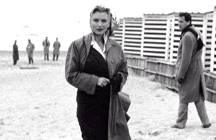 February returns a pair of long unseen classic films to light in the Pacific Northwest: The 1965 Battle of Algiers by Gillo Pontecorvo and 1953’s I Vitelloni from Federico Fellini. How I wish that time were on the side of both. That fickle unity serves the Pontecorvo extraordinarily well; the Fellini, as much as I wanted to love it, I can only admire.
February returns a pair of long unseen classic films to light in the Pacific Northwest: The 1965 Battle of Algiers by Gillo Pontecorvo and 1953’s I Vitelloni from Federico Fellini. How I wish that time were on the side of both. That fickle unity serves the Pontecorvo extraordinarily well; the Fellini, as much as I wanted to love it, I can only admire.
Much of the imagery in Fellini’s I Vitelloni feels remote, dimmed by time. Although this now 51-year-old film remains stunning in patches, and painfully accurate in etching the desperate sleaziness of human exploits, I Vitelloni, overall, left me cold and unsatisfied.
The situations, among them a brother objecting to his sister’s affair with a married man, are pure soap opera; and Fellini’s fleeting scenarios (the archetypal stock characters watch their hopes turn into horrors, again and again) aren’t particularly well explored. The writer-director illustrates his lone point that his 20-something male protagonists are either unmotivated oafs or starry dreamers, then gives us nothing else to go on. (The film’s title translates as “the fatted calves.”)
Nino Rota’s diamond shining brilliance has alone preserved its youth—or its youthfulness. His music still sounds eerie and modern, as fresh as tomorrow, with bell-toned ornamental trills rising up where least we expect them and deep organ lurches plowing the ground out from beneath us.
 There’s also one non-Rota musical moment that’s perfectly right. Fausto, the most shiftless of the vagabonds on display, takes perverse delight in hitting on his boss’s wife while the two of them are alone together in a store stockroom. Fausto (Franco Fabrizi) and the significantly older Giulia (played by the Czech actress Lida Baarová, who was once romantically linked with Joseph Goebbels and subsequently charged with treason and espionage) end up on the floor searching for candles; the young man taunts her sexually—to arouse Giulia so that he can laugh cruelly at her wants—and in the background, a music box plays its mechanical version of the Wilhelm Grosz sentimental pop hit “Isle of Capri”—a delicious master stroke of irony.
There’s also one non-Rota musical moment that’s perfectly right. Fausto, the most shiftless of the vagabonds on display, takes perverse delight in hitting on his boss’s wife while the two of them are alone together in a store stockroom. Fausto (Franco Fabrizi) and the significantly older Giulia (played by the Czech actress Lida Baarová, who was once romantically linked with Joseph Goebbels and subsequently charged with treason and espionage) end up on the floor searching for candles; the young man taunts her sexually—to arouse Giulia so that he can laugh cruelly at her wants—and in the background, a music box plays its mechanical version of the Wilhelm Grosz sentimental pop hit “Isle of Capri”—a delicious master stroke of irony.
It isn’t Fellini’s fault that a half-century’s worth of homage paid to this film has robbed it of currency. However, during an impromptu mambo on a cobbled street, his camera seems to love being in the wrong place. Instead of filling the frame with his merry hoofers, Fellini inserts reaction shots that detract from the sense of spontaneity.
 More significantly, besides the abomination Fausto, only Sandra (Leonora Ruffo), the local “Miss Mermaid” contest winner whom Fausto impregnates and later marries, emerges as a well-defined personality. The drag queen/clown Alberto (overacted by Alberto Sordi, who just a year before I Vitelloni had played to perfection the title role in Fellini’s The White Sheik) isn’t anything more than an effeminate gasbag, and Leopoldo, who longs to be recognized for his efforts as a playwright, rises to the foreground only in a single sequence. Leopoldo’s humiliation at the hands of a homosexual actor still possesses the power to make our flesh creep. This nocturnal seaside bait-and-switch encounter, “partakes equally of the risible, the macabre, and the pitiful,” so John Simon noted in Private Screenings. (Macabre and pitiful, yes. But I found this freak show garden path too clammy for laughter.) And Leopoldo (Leopoldo Trieste) seems not to exist save for the sole purpose of being bashed this way. Worse still, there is the inexplicable attachment that Moraldo (Franco Interlenghi) forms to an androgynous young railroad worker named Guido. Are their scenes together supposed to be homoerotic? (Christ, I hope not.) Or does Fellini suggest that Moraldo’s case of arrested development can be abated by the genuine naïveté of this child? Whatever the rationale, I was unconvinced by the pairing.
More significantly, besides the abomination Fausto, only Sandra (Leonora Ruffo), the local “Miss Mermaid” contest winner whom Fausto impregnates and later marries, emerges as a well-defined personality. The drag queen/clown Alberto (overacted by Alberto Sordi, who just a year before I Vitelloni had played to perfection the title role in Fellini’s The White Sheik) isn’t anything more than an effeminate gasbag, and Leopoldo, who longs to be recognized for his efforts as a playwright, rises to the foreground only in a single sequence. Leopoldo’s humiliation at the hands of a homosexual actor still possesses the power to make our flesh creep. This nocturnal seaside bait-and-switch encounter, “partakes equally of the risible, the macabre, and the pitiful,” so John Simon noted in Private Screenings. (Macabre and pitiful, yes. But I found this freak show garden path too clammy for laughter.) And Leopoldo (Leopoldo Trieste) seems not to exist save for the sole purpose of being bashed this way. Worse still, there is the inexplicable attachment that Moraldo (Franco Interlenghi) forms to an androgynous young railroad worker named Guido. Are their scenes together supposed to be homoerotic? (Christ, I hope not.) Or does Fellini suggest that Moraldo’s case of arrested development can be abated by the genuine naïveté of this child? Whatever the rationale, I was unconvinced by the pairing.
All that said, this 1953 work nonetheless towers above the director’s dismal endeavors from the 1970s and ‘80s. (In the minority opinion as I so often am, I don’t share the world’s nodding approval of Amarcord.) I Vitelloni lacks the incisive fancifulness of either The White Sheik or 8½, Fellini’s two masterpieces; and it lacks the almost perfectly controlled telescopic gaze into the abyss that makes Nights of Cabiria a near-masterpiece. I Vitelloni closes with a sublime early morning montage of sleepers in their beds. It seems a truly loving gesture—the camera sweeps in for a long, high view and moves without fuss on to the next bedroom—this glimpse of deep peace from which sleepers must inevitably awake. – NPT
February 2004

You must be logged in to post a comment.